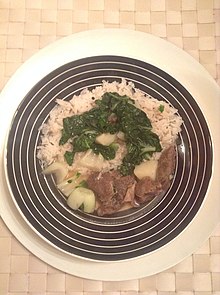Nilaga
 | |
| Type | Stew/Soup |
|---|---|
| Place of origin | Philippines |
| Similar dishes | Bulalo, Lauya, Cansi |
Nilaga (also written as nilagà) is a traditional meat stew or soup from the Philippines, made with boiled beef (nilagang baka) or pork (nilagang baboy) mixed with various vegetables. It is typically eaten with white rice and is served with soy sauce, patis (fish sauce), labuyo chilis, and calamansi on the side.[1]
Description[edit]

Nilaga is one of the simplest dishes in the Philippines. It typically uses tender and fatty cuts of meat like sirloin, pork belly, ribs or brisket. These are boiled until fork-tender then spiced with onions, garlic, salt, whole black peppercorns, scallions, patis (fish sauce), and sometimes lemongrass, ginger, star anise, or bay leaves. The broth is also commonly enriched with bouillon cubes. Various vegetables are then added with the dish. The most basic vegetables used are pechay (or cabbage) and potatoes. Other vegetables that can be used include carrots, saba bananas, calabaza, string beans, tomatoes, celery, broccoli, cauliflower, chayote, corn on the cob, baby corn, bell peppers, and sweet potatoes, among others.[2][3][4][5][6][7]
Nilaga can be eaten on its own, but it is typically eaten with white rice. It is served with soy sauce, patis (fish sauce), labuyo chilis, and calamansi on the side, which can be added to taste.[5]
Similar dishes[edit]
Chicken or seafood versions of the dish are usually called tinola. Nilaga is very similar to other dishes like bulalo, linat-an, lauya, and cansi. Nilaga can be distinguished in that it has a broth (bouillon) base, made with tender meaty and fatty cuts of beef or pork. The other dishes have a stock base, made by using bone marrow and collagen-rich cuts of beef and pork (like beef shank and ham hocks).[8][9]
"Nilaga" (which means "boiled" in Tagalog) is also used for other unrelated dishes like boiled peanuts, corn on the cob, or saba bananas.[10]
See also[edit]
References[edit]
- ^ "Nilagang Baboy (Boiled Pork and Vegetables)". Casa Veneracion. Retrieved September 9, 2021.
- ^ Cailan, Alvin; Cuerdo, Alexandra (2020). Amboy: Recipes from the Filipino-American Dream. Houghton Mifflin Harcourt. pp. 27–28. ISBN 9781328931733.
- ^ "Nilagang Baboy". Pinoy Cooking Recipes. Retrieved September 9, 2021.
- ^ "Nilagang Baboy". Lutong Filipino. January 9, 2015. Retrieved September 9, 2021.
- ^ a b "Nilagang Baka Recipe". Panlasang Pinoy. Retrieved September 9, 2021.
- ^ Besa-Quirino, Betty Ann (May 6, 2018). "Nilagang Baboy- Pork Stew with Vegetables". Asian in America. Retrieved September 9, 2021.
- ^ "Beef Nilaga Pressure Cooker Recipe (Nilagang Baka)". Riverten Kitchen. May 29, 2019. Retrieved September 9, 2021.
- ^ Miranda, Roselle. "What's The Difference: Bulalo vs Nilaga". Yummy.ph. Retrieved September 9, 2021.
- ^ "Bulalo (Beef with Bone Marrow Soup)". Easy Filipino Cooking. April 2021. Retrieved September 9, 2021.
- ^ Ponseca, Nicole; Trinidad, Miguel (2018). I Am a Filipino: And This Is How We Cook. Artisan Books. pp. 31, 96. ISBN 9781579658823.

